Misperceptions Create Significant Bond Market Value
Interest-Rates / US Bonds Jul 24, 2015 - 02:05 PM GMTBy: John_Mauldin
 In today’s Outside the Box, my good friend Lacy Hunt of Hoisington Investment Management reminds us that since the 1990-91 recession, the 30-year Treasury bond yield has dropped from 9% to 3%, a downward move nearly identical to the decline in the rate of inflation, which fell from just over 6% in 1990 to 0% today. Therefore, Lacy says, “(I)t was the backdrop of shifting inflationary circumstances that once again determined the trend in long-term Treasury bond yields.”
In today’s Outside the Box, my good friend Lacy Hunt of Hoisington Investment Management reminds us that since the 1990-91 recession, the 30-year Treasury bond yield has dropped from 9% to 3%, a downward move nearly identical to the decline in the rate of inflation, which fell from just over 6% in 1990 to 0% today. Therefore, Lacy says, “(I)t was the backdrop of shifting inflationary circumstances that once again determined the trend in long-term Treasury bond yields.”
During that 25-year period, though, there have been nine significant backups, when yields rose an average of 127 basis points, despite weakening inflation. Lacy attributes these periods to an “intermittent change in psychology … a strong sentiment that the rise marked the end of the bull market, and a major trend reversal was taking place.”
It’s happening again today, Lacy asserts; and he ticks off four misperceptions that have pushed Treasury bond yields to levels that represent significant value for long-term investors. They are:
- The recent downturn in economic activity will give way to improving conditions and even higher bond yields.
- Intensifying cost pressures will lead to higher inflation/yields.
- The inevitable normalization of the Federal Funds rate will work its way up along the yield curve causing long rates to rise.
- The bond market is in a bubble, and like all manias, it will eventually burst.
Lacy builds a strong case that fundamental economic forces are exerting downward, rather than upward, pressure on inflation. It’s a contrarian view – certainly not mainstream at this moment – but considering that Lacy has been right for well over 30 years, consistently pointing out through the nine periods when everybody was proclaiming the end of the bond bull market that the fundamentals were still pointing in the direction of lower interest rates.
I’ve had some late-night discussions with Lacy trying to figure out what would make him a bond market bear, and we have discussed what it would take for rates to truly rise long-term. I look around, and right now I don’t see those conditions.
Inflation is close to zero (as measured by the CPI) over the last 12 months. Commodity prices are back where they were 13 years ago (Bloomberg Index in chart below). The Fed is on track to, maybe, kind of, sort of, timidly, slowly raise interest rates starting sometime this fall, with Janet Yellen suggesting in her latest testimony that September might be the date. If trading runs to form, that will make the dollar stronger and put further pressure on price inflation. Just because rates go up on the short end of the curve does not mean the long end will follow. The tail does not necessarily wag this dog.
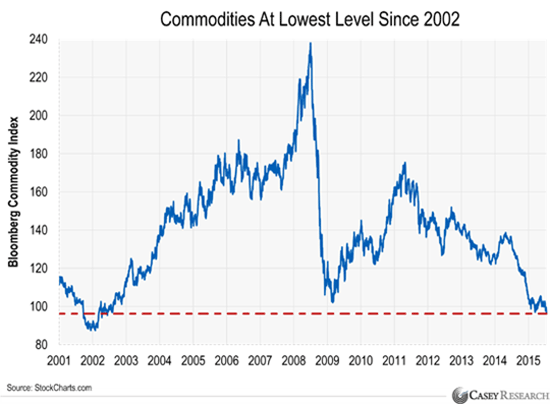
Make no mistake, I think that one day rates are going to rise and we will see the end of this bond bull market. I’ve been on the record for multiple years now that we’re going to see a final low in interest rates in the next recession, whenever that is. When that time comes you need to be ready to back up the truck and refinance every bit of debt that you can. In the meantime take advantage of the low rates at the low end of the curve. And pay attention to Lacy.
I was in the gym this afternoon training with The Beast. He normally plays rock ’n roll and heavy metal and we pump iron to a heavy beat. For whatever reason today, he was playing pop country. I know I’m from Texas and all, but I’ve just never been a big fan of country music. My kids didn’t hear it growing up, but several of them have become big country-western fans. Even my middle son, Chad, who likes to listen to rap and other similarly worthless attempts at music, has now become a country-western fan. That was one I didn’t see coming.
One of the singers started talking about the things he liked about growing up country: sweet tea, juicy cantaloupe, cane poles, and rebel flags – a litany of growing up in simpler times in the country. Each image in the singer’s long list brought back good memories. I doubt many of the younger generation have ever actually fished with a cane pole and cork bobber with twine, but the image still seems to make them wax nostalgic.
It’s a symbol, and like all symbols it invokes emotions and feelings. A good writer is constantly using symbols to create a mood for his readers, giving us word pictures that move us or inspire us, make us angry or fearful, make us joyous or peaceful.
Interestingly, I seem to find that same nostalgic mix everywhere in the world I go. I suppose it’s tied up with family and friends. In a world that seems to change around us moment by moment, we want to hold on to a few things we think are dependable.
Right now my plans are to drive down to the south of Austin on Sunday and spend the evening with George and Meredith Friedman. George has a home deep in the hills of Texas, and it’s been too long since we’ve been able to sit down and review what’s happening in the world. What better way to spend a summer day? I’m really looking forward to it. I have reason to believe we might be able to find a country station or three or four on that road trip. A little nostalgia every now and then is good for the soul.
Have a great week. Maybe I’ll even see if Lacy is around and drop by his office on the way back to Dallas. But for right now, let’s take a look at his latest essay.
Your watching the world go by too fast analyst,
John Mauldin, Editor
Outside the Boxsubscribers@mauldineconomics.com
Hoisington Quarterly Review and Outlook – Second Quarter 2015
Misperceptions Create Significant Bond Market Value
From the cyclical monthly high in interest rates in the 1990-91 recession through June of this year, the 30-year Treasury bond yield has dropped from 9% to 3%. This massive decline in long rates was hardly smooth with nine significant backups. In these nine cases yields rose an average of 127 basis points, with the range from about 200 basis points to 60 basis points (Chart 1). The recent move from the monthly low in February has been modest by comparison. Importantly, this powerful 6 percentage point downward move in long-term Treasury rates was nearly identical to the decline in the rate of inflation as measured by the monthly year-over-year change in the Consumer Price Index which moved from just over 6% in 1990 to 0% today. Therefore, it was the backdrop of shifting inflationary circumstances that once again determined the trend in long-term Treasury bond yields.
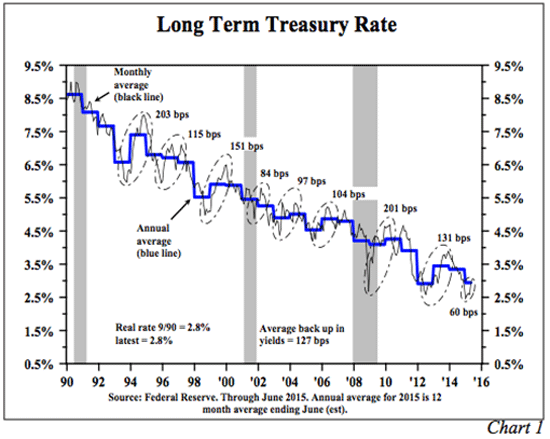
In almost all cases, including the most recent rise, the intermittent change in psychology that drove interest rates higher in the short run, occurred despite weakening inflation. There was, however, always a strong sentiment that the rise marked the end of the bull market, and a major trend reversal was taking place. This is also the case today.
Presently, four misperceptions have pushed Treasury bond yields to levels that represent significant value for long-term investors. These are:
- The recent downturn in economic activity will give way to improving conditions and even higher bond yields.
- Intensifying cost pressures will lead to higher inflation/yields.
- The inevitable normalization of the Federal Funds rate will work its way up along the yield curve causing long rates to rise.
- The bond market is in a bubble, and like all manias, it will eventually burst.
Rebounding Economy and Higher Yields
The most widely held view of these four misperceptions is that the poor performance of the U.S. economy thus far in 2015 is due to transitory factors. As those conditions fade, the economy will strengthen, sparking inflation and causing bond yields to move even higher. The premise is not compelling, as there is solid evidence of a persistent shift towards lower growth. Industrial output is expected to decline more in the second quarter than the first. This will be the only back-to-back decrease in industrial production since the recession ended in 2009 (Chart 2). Any significant economic acceleration is doubtful without participation from the economy’s highest value-added sector. To be sure, the economy recorded higher growth in the second quarter, but that was an easy comparison after nominal and real GDP both contracted in the first quarter.
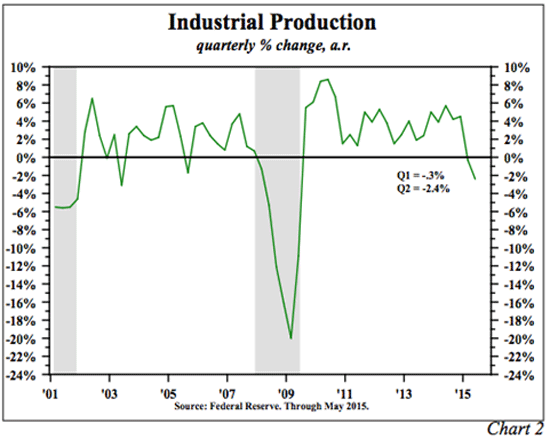
Adding to a weak manufacturing sector, other fundamentals continue to indicate that top- line growth will not accelerate further this year, and inflation will be contained. M2 year-over-year growth has slipped below the growth rates that prevailed at year-end. The turnover of that stock of money, or velocity, is showing a sharp deceleration. Presently M2 velocity is declining at a 3.5% annual rate, and there are signs that it may decline even faster. If growth in M2 or velocity subsides much further, then nominal GDP growth is unlikely to reach the Fed’s recently revised forecast of 2.6% this year (M*V=Nominal GDP).
At year-end 2014 the Fed was forecasting nominal GDP growth to accelerate to 4.1% this year, compared with 3.7% and 4.6% actual increases in 2014 and 2013, respectively. In six months the Fed has once again been forced to admit it's error and has massively lowered its forecast of nominal growth to 2.6%. Additionally, the Fed formerly expected a 2.8% increase in real GDP and now anticipates only a 1.9% increase in 2015, down from 2.4% and 3.1% in 2014 and 2013, respectively. The inflation rate forecast was also lowered by 60 basis points.
Transitory increases in long Treasury bond yields are not likely to be sustained in an environment of a pronounced downward trend in growth in both real and nominal GDP. However the expectation of lower long rates is also bolstered by the well-vetted economic theory of “the Wicksell effect” (Knut Wicksell 1851-1926).
Wicksell suggested that when the market rate of interest exceeds the natural rate of interest funds are drained from income and spending to pay the financial obligations of debtors. Contrarily, these same monetary conditions support economic growth when the market rate of interest is below the natural rate of interest as funds flow from financial obligations into spending and income. The market rate of interest and the natural rate of interest must be very broad in order to capture the activities of all market participants. The Baa corporate bond yield, which is a proxy for a middle range borrowing risk, serves the purpose of reflecting the overall market rate of interest. The natural rate of interest can be captured by the broadest of all economic indicators, the growth rate of nominal GDP.
In comparing these key rates it is evident that the Wicksell effect has become more of a constraint on growth this year. For instance, the Baa corporate bond yield averaged about 4.9% in the second quarter. This is a full 230 basis points greater than the gain in nominal GDP expected by the Fed for 2015. By comparison, the Baa yield was only 70 basis points above the year-over-year percent increase in nominal GDP in the first quarter.
To explain the adverse impact on the economy today of a 4.8% Baa rate verses a nominal GDP growth rate of 2.6% consider a $1 million investment financed by an equal amount of debt. The investment provides income of $26,000 a year (growth rate of nominal GDP), but the debt servicing (i.e. the interest on Baa credit) is $48,000. This amounts to a drain of $22,000 per million. Historically the $1 million investment would, on average, add $2,500 to the annual income spending stream. Over the past eight decades, the Wicksell spread averaged a negative 25 basis points (Chart 3).
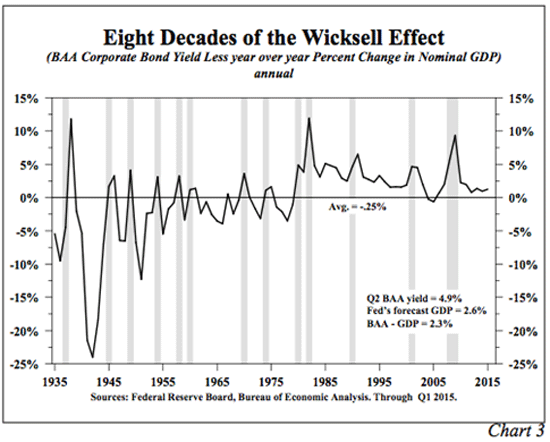
Since 2007 however, the market rate of interest has been persistently above the natural rate, and we have experienced an extended period of subpar economic performance. Also, during these eight years the economy has been overloaded with debt as a percent of GDP and, unfortunately, too much of the wrong type of debt. The ratio of public and private debt moved even higher over the past six months suggesting that the Wicksell effect is likely to continue enfeebling monetary policy and restraining economic growth and inflation.
Cost Push Inflation Means Higher Yields
The second misperception is more subtle. The suggestion is that higher health care and/or wage costs will force inflation higher. It follows, therefore, that Treasury bond yields will rise as they are heavily influenced by inflationary expectations and conditions. Further, this higher inflation will cause the Fed to boost the federal funds rate.
Some argue that health care insurance costs are projected to rise very sharply, with some companies indicating that premiums will need to rise more than 50% due to the Affordable Care Act. Even excluding the extreme increases in medical insurance costs, many major carriers have announced increases of 20% or more. Others argue that the six-year low in the unemployment rate will cause wage rates to accelerate.
Four considerations cast doubt on these cost- push arguments. First, increases in costs for medical care, which has inelastic demand, force consumers to cut expenditures on discretionary goods with price elastic demand. Goods with inelastic demand do not have many substitutes while those with elastic demand have many substitutes. When an economy is experiencing limited top-line growth, as it is currently, the need to make substitute-spending preferences is particularly acute. Thus, discretionary consumer prices are likely to be forced lower to accommodate higher non-discretionary costs, leaving overall inflation largely unchanged.
Second, alternative labor market measures indicate substantial slack remains and evidence is unconvincing that wage rates are currently rising to any significant degree. The U.S. Government Accountability Office (GAO) released a report that looks at the “contingent workforce” (Wall Street Journal, May 28, 2015). These are workers who are not full-time permanent employees. In the broadest sense, the GAO found these workers accounted for 40.4% of the workforce in 2010, up from 35.3% in 2006. The GAO found that this growth mainly results from an increase in permanent part-timers, a category that grew as employers reduced hours and hired fewer full-time workers. The GAO also said that the actual pay earned was nearly 50% less for a contingent worker than a person with a steady full time job. The process portrayed in the study undermines the validity of the unemployment rate as an indicator because a person is counted as employed if they work as little as one hour a month. Additionally there is an upward bias on average hourly earnings due to the difference in hours worked between full-time and contingent workers.
Third, corporate profits and closely aligned productivity measures are more consistent with declining, rather than strengthening, wage increases. After peaking in the third quarter of 2013, profits after tax and adjusted for inventory gains/losses and over/under depreciation have fallen by 16% (Chart 4). Over the past four years, nonfarm business productivity increased at a mere 0.6% annual rate, the slowest pace since the early 1980s. A significant wage increase would cut substantially into already thin profits as top-line growth is decelerating, and the dollar hovers close to a 12.5 year high. Together the profits and productivity suggest that firms need to streamline operations, which would entail reducing, rather than expanding, employment costs.
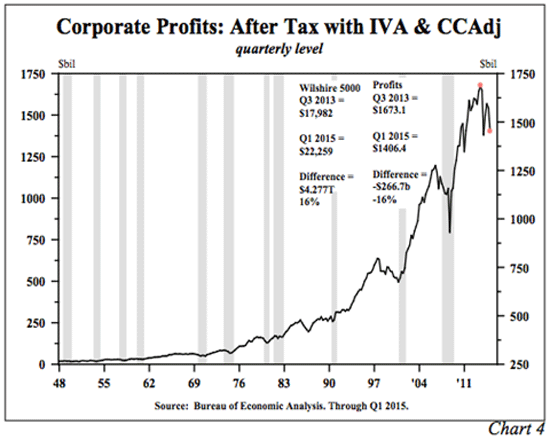
Fourth, experience indicates inflationary cycles do not start with rising cost pressures. Historically, inflationary cycles are characterized by “a money, price and wage spiral” and in that order. In other words, money growth must accelerate without an offsetting decline in the velocity of money. When this happens, aggregate demand pulls prices higher, which, in turn, leads to faster wage gains. The upturn leads to a spiral when the higher prices and wages are reinforced by another even faster growth in money not thwarted by velocity. Current trends in money and velocity are not consistent with this pattern and neither are prices and wages.
Normalizing the Federal Funds Rate
A third argument is that the Fed needs to normalize rates, and as they do this, yields will also rise along the curve. It is argued the Fed has held the federal funds rate at the zero bound for a long time with results that are questionable, if not detrimental, to economic growth. Proponents for this argue that the zero bound may have resulted in excessive speculation in stocks and other assets. This excess liquidity undoubtedly boosted returns in the stock market, but the impact on economic activity was not meaningful. At the same time, the zero bound and the three rounds of quantitative easing reduced income to middle and lower range households who hold the bulk of their investments in the fixed income markets. Thus, to reverse the Fed’s inadvertent widening of the income and wealth divide, the economy will function better with the federal funds rate in a more normal range. Also, by raising short-term rates now, the Fed will have room to lower them later if the economy worsens.
Normalization of the federal funds rate is widely accepted as a worthwhile objective. However, achieving normalization is not without its costs. In order to increase the federal funds rate, the Fed will raise the interest rate on excess reserves of the depository institutions (IOER). Also, the Fed will have to shrink the $2.5 trillion of excess reserves owned by the depository institutions by conducting reverse repurchase agreements. This is in addition to operations needed to accommodate shifts in excess reserves caused by fluctuations in operating factors, such as currency needs of the non- bank public, U.S. Treasury deposits at the Fed and Federal Reserve float. If increases in the IOER do not work effectively, the Fed will then need to sell outright from its portfolio of government securities, causing an even more significant impact out the yield curve. The Fed’s portfolio has close to a seven-year average maturity.
A higher federal funds rate and reduced monetary base would place additional downward pressure on both money growth and velocity, serving to slow economic activity. Productivity of debt has a far more important influence on money velocity than interest rates. Nevertheless, higher interest rates would cause households and businesses to save more and spend less, which, in turn, would work to lower money velocity. Such a policy consequence is highly unwelcome since velocity fell to a six decade low in the first quarter and another drop clearly appears to have occurred in the second quarter.
These various aspects of the Fed’s actions would, all other things being equal, serve to reduce liquidity to the commodity, stock and foreign exchange markets while either placing upward pressure on interest rates or making them higher than otherwise would be the case. Stock prices and commodity prices would be lower than they otherwise. In addition the dollar would be higher than otherwise would be the case deepening the deficit between imports and exports of goods and services.
Increases in the federal funds rate would be negative for economic activity. As the Fed’s restraining actions become apparent, however, the Fed could easily be forced to lower the federal funds rate, making increases in market interest rates temporary.
The predicament the Fed is in is one that could be anticipated based on the work of the late Robert K. Merton (1910-2003). Considered by many to be the father of modern day sociology, he was awarded the National Medal of Science in 1994 and authored many outstanding books and articles. He is best known for popularizing, if not coining, the term “unanticipated consequences” in a 1936 article. He also developed the “theory of the middle range”, which says undertaking a completely new policy should proceed in small steps in case significant unintended problems arise. As the Fed’s grand scale experimental policies illustrate, anticipating unintended consequences of untested policies is an impossible task. For that reason policy should be limited to conventional methods with known outcomes or by untested operations only when taken in small and easily reversible increments.
Bond Market Bubble
The final argument contends that the Treasury bond market is in a bubble, and like all manias, it will burst at some point. In The New Palgrave, Charles Kindleberger defined a bubble up as ..." a sharp rise in the price of an asset or a range of assets in a continuous process, with the initial rise generating expectations of further rises and attracting new buyers". The aforementioned new buyers are more interested in profits from “trading the asset than its use or earnings capacity”. For Kindleberger the high and growing price is unjustified by fundamental considerations. In addition Kindelberger felt that the price gains were fed by ‘momentum’ investors who buy, usually with borrowed funds, for the sole purpose of selling to others at a higher price. For Kindleberger, a large discrepancy between the fundamental price and the market price reflected excessive debt increases. This condition is referred to as “overtrading”. At some point, perhaps after a prolonged period of time, astute investors will begin to recognize the gap between market and fundamental value. They will begin to sell assets financed by debt, or their creditors may see this gap and deny the speculators credit. Charles Kindleberger called this process “discredit”. For Kindleberger, the word discredit was designed to capture the process of removing some of the excess debt creation. The phase leads into the popping of the bubble and is called “revulsion”.
The issue in determining whether or not a bubble exists is to determine what constitutes fundamental value. For stocks this is generally considered to be after-tax earnings, cash flow or some combination of the two and the discount rate to put these flows in present value terms. Most experts who have addressed this issue of economic fundamentals have confined their analysis to assets like stocks or real estate. In the Palgrave article Kindelberger did not specifically cover the case of bonds. We could not find discussions by well- recognized scholars that explicitly defined a Treasury bond value or a market bubble. The reason is that there is no need.
To be consistent with well-established and thoroughly vetted theory, the economic value of long-term Treasury bonds is determined by the relationship between the nominal yield and inflationary expectations, or the real yield. To assess the existence of a Treasury bond bubble one must evaluate the existing real yield in relation to the historic pattern of real yields. If the current real yield is well above the long-term historic mean then the Treasury bond market is not in a bubble. However, if the current real yield is significantly below this mean, then the market is in a bubble. By this standard, the thirty-year Treasury bond is far from a bubble. In the past 145 years, the real long bond yield averaged 2.1%. At a recent nominal yield of 3.1% with a year over year increase in inflation of 0.1%, the real yield stands at 3%, 50% greater value than investors have, on average, earned over the past 145 years. Indeed, the real yield is virtually the same as in 1990 when the nominal bond yield was 9%. Contrary to the Treasury bond market being in a bubble, errant concerns about inflation or other matters have created significant value for this asset class.
Conclusion
In summary, economic theory and history do not suggest the secular low in inflation, or that its alter ego, Treasury bond yields, is at hand. The excessive debt burden, slow money growth, declining money velocity, the Wicksell effect and the high real rate of interest indicate that the fundamental elements are exerting downward, rather than upward, pressure on inflation. Inflation will not trough as long as the US economy continues to become even more indebted. While Treasury bond yields have repeatedly shown the ability to rise in response to a multitude of short-run concerns that fade in and out of the bond market on a regular basis, the secular low in Treasury bond yields is not likely to occur until inflation troughs and real yields are well below long-run mean values. We therefore continue to comfortably hold our long-held position in long-term Treasury securities.
Like Outside the Box?
Sign up today and get each new issue delivered free to your inbox.
It's your opportunity to get the news John Mauldin thinks matters most to your finances.
John Mauldin Archive |
© 2005-2022 http://www.MarketOracle.co.uk - The Market Oracle is a FREE Daily Financial Markets Analysis & Forecasting online publication.



